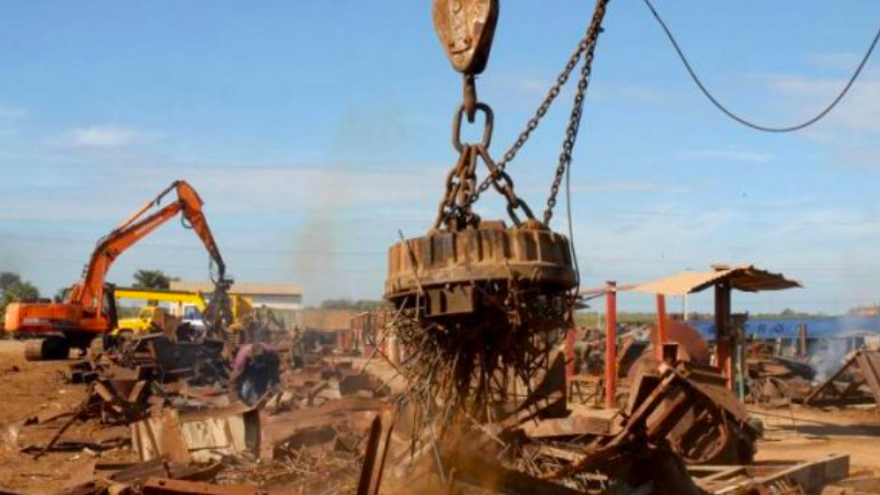
![]() 14ymedio, Havana, 13 October 2023 — The directors of the Recycling Company congratulated themselves this Thursday on Cuban State TV’s Roundtable program for being one of the few “industries” in the country that has overfulfilled its plan: so far this year, the company has collected 74,000 tons of raw material and collected more than 41.6 million dollars, of which 29 million come from export.
14ymedio, Havana, 13 October 2023 — The directors of the Recycling Company congratulated themselves this Thursday on Cuban State TV’s Roundtable program for being one of the few “industries” in the country that has overfulfilled its plan: so far this year, the company has collected 74,000 tons of raw material and collected more than 41.6 million dollars, of which 29 million come from export.
The president of the business group, Jorge Luis Tamayo, regretted that the economic consequences of the coronavirus pandemic did not allow him to achieve “superior results.” Even so, there was success with what was accumulated between the “fixed” recycling points, which collected 16,400 tons, and the “mobile” points – which collected 16,000. In addition, state schools and organizations, contributed 1,500 tons. The Communal Services, which should carry the weight of the collection, only delivered about 1,900 tons to Recycling, the leader complained.
Nothing exceeds, however, the capacity of the Island’s hotels to generate garbage, which Recycling then purges and collects. So far this year, tourist establishments have “provided” the not-inconsiderable amount of 2,240 tons of usable raw material, 556 more than last year.
Tamayo said that, in addition to selling the raw material, his company uses it to manufacture 65 products “without executing large investments”
Tamayo said that, in addition to selling the raw material, his company uses it to manufacture 65 products “without executing large investments.” What generates the most money – and therefore, what is most exported – are “carton packaging, plastics, glass, parts, pieces, aggregates, laminates, pipes and ball bearings.” In addition, the sale of non-metallic scrap managed to bring in five million dollars.
What is reinvested in the maintenance of recycling equipment is minimal: about 109 million pesos, Tamayo said. His company, in addition, benefits from a “closed scheme of foreign exchange financing” – for which other sectors, like publishing, have advocated, without success – and from “a differentiated exchange rate” of 1 dollar for 120 pesos, which the leader described as “fundamental for the organization.”
Tamayo proudly said that Recycling knows how to take advantage of any setback. In the greatest disasters of recent years – the gas exposion that collapsed the Saratoga Hotel, the fire at the Matanzas Supertanker Base and the collapse of the mezzanine in a tower of the Antonio Guiteras thermoelectric plant – his company has collected and reused the materials that were no longer usable in the reconstruction.
The director of the Recycling company in Havana, Rosa Reyes, was not so optimistic about the situation. During her speech, she admitted that in the capital no one is too interested in recycling, and she attributed this to the “great dissatisfaction of the population,” besieged by the “energy situation” and the fact that habaneros throw garbage on the street without distinguishing between materials that are recyclable and those that are not.
The recyclable product, once it is mixed with garbage, loses quality, loses value and is very difficult to recover
“The recyclable product, once it is mixed with garbage, loses quality, loses value and is very difficult to recover,” she said. On the other hand, “Havana doesn’t have the optimal infrastructure to be able to make that sourcing of recyclable materials from home,” she said, referring to the absence of containers and baskets on the streets. However, she ended up calling on Cubans to have “a little discipline and conscience.” The collection of raw materials, she insisted, could help the “home economy.”
Although burdened by health restrictions during the pandemic, the collection of raw materials was the livelihood of many elderly and low-income people in Cuba. On the streets of the Island, it is also common to see beggars collecting cans and cartons that they then sell at recycling points for a few pesos.
The phenomenon carries a serious health risk, since the search for these items is carried out without the slightest protection, and it is not uncommon to find “dumpster divers” – people who dive into the containers looking for materials and food – rummaging through the garbage. Tamayo and Reyes alluded to none of this, setting their sights set on how lucrative the business has become.
Both managers ended the program with a call to the micro, small and medium-sized companies of the Island to join their “action” to increase the profits of Recycling. “We are urging everyone,” Tamayo concluded.
Translated by Regina Anavy
____________
COLLABORATE WITH OUR WORK: The 14ymedio team is committed to practicing serious journalism that reflects Cuba’s reality in all its depth. Thank you for joining us on this long journey. We invite you to continue supporting us by becoming a member of 14ymedio now. Together we can continue transforming journalism in Cuba.
